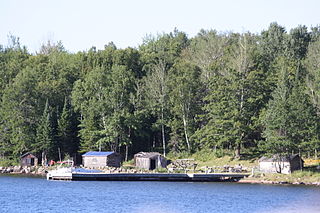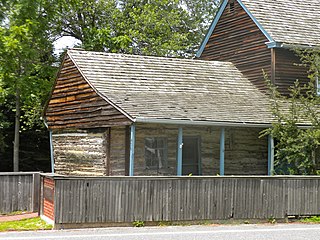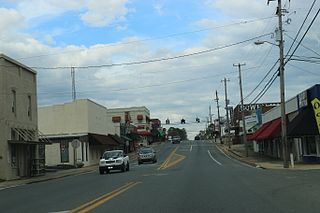
Manitou Camp is a logging and fishing camp started in the 1890s on Manitou Island, part of the Apostle Islands National Lakeshore. Today, as historically, Manitou Camp is used as a campground and as a facility for fishing. It has been listed on the National Register of Historic Places since 1983 and is owned by the National Park Service.

Bryce Canyon Lodge is a lodge in Bryce Canyon National Park, Utah, United States. It was built between 1924 and 1925 using local materials. Designed by architect Gilbert Stanley Underwood, the lodge is an excellent example of National Park Service Rustic design. It is the only remaining completely original structure of the lodges designed by Underwood for Bryce Canyon National Park, Zion National Park and the North Rim of the Grand Canyon.

The Dewitt Log Homestead is a registered historic building near Oxford, Ohio, listed in the National Register on 1973-04-13.

The Thomas Select School is a historic log building in rural Butler County, Ohio, United States. Constructed in 1810, the building has seen numerous uses, ranging from church to school to house. It has been named a historic site.

The Roosevelt Lodge Historic District comprises the area around the Roosevelt Lodge in the northern part of Yellowstone National Park, near Tower Junction. The district includes 143 buildings ranging in size from cabins to the Lodge, built beginning in 1919. The Lodge was first conceived as a field laboratory for students and educators conducting research in the park. It later became a camp for tourists, specifically designed to accommodate automobile-borne tourists. The Lodge is a simplified version of the National Park Service Rustic style.

The Moran Bay Patrol Cabin was built by the Civilian Conservation Corps about 1932. The log structure was located in the northern backcountry of Grand Teton National Park, and was built to a standard design for such structures, in the National Park Service Rustic style, but for the U.S. Forest Service, which administered much of the area prior to the expansion of the park in 1943. The Upper Granite Canyon Patrol Cabin is similar.

The Squirrel Meadow Guard Station is a ranger station in the backcountry of Targhee National Forest in Wyoming. The original facility was established in 1907, with the present structures built in 1934. The log cabin station is an example of a standard US Forest Service backcountry patrol structure.

The Red Star Lodge and Sawmill, also known as the Shoshone Lodge, is a dude ranch in Shoshone National Forest near the east entrance to Yellowstone National Park. Built between 1924 and 1950, the ranch includes a rustic log lodge surrounded by cabins and support buildings. What is now called the Shoshone Lodge is the most intact example of a dude ranch operation in the area.

The Ford Creek Patrol Cabin in Glacier National Park was built in 1928. The National Park Service Rustic log structure is a significant resource both architecturally and historically as a network of shelters, approx. one day's travel apart, for patrolling backcountry rangers.

The Nancy Lincoln Inn is a historic building located at the Abraham Lincoln Birthplace National Historic Site in LaRue County, Kentucky, just south of Hodgenville, Kentucky. Despite being on National Park Service property, it is privately owned.

The Andrew Berg Cabin near Soldotna, Alaska was built by fisherman and trapper Andrew Berg in 1902. It was listed on the National Register of Historic Places in 2000.

C. A. Nothnagle Log House is a historic house on Swedesboro-Paulsboro Road near Swedesboro in the Gibbstown section of Greenwich Township, Gloucester County, New Jersey, United States. It is one of the oldest surviving log houses in the United States.

The Tall Pines Inn is a historic log cabin resort located at the junction of Pivot Rock Road and United States Route 62 in Eureka Springs, Arkansas. Established in 1947, it features six rustic cabins built from surrounding forests and modernized to meet the needs of today's traveler. Besides these cabins, which are of log construction, the inn has three suites which are part of the original log residence, twelve other cabins/suites with wood siding, and a swimming pool.

Lower Swedish Cabin is an historic Swedish-style log cabin on Creek Road in Drexel Hill, Pennsylvania, along Darby Creek. The cabin may be one of the oldest log cabins in the United States.

The Timberline Cabin in Rocky Mountain National Park, Colorado, USA was built in 1925 to house workers on the Fall River Road. The National Park Service rustic style cabin was designed by the National Park Service's Landscape Engineering Division under the direction of Thomas Chalmers Vint. The cabin was later used as a patrol cabin and as a caretaker's residence.

The Thunder Lake Patrol Cabin is a small structure in Rocky Mountain National Park, Colorado. Built in 1930, the 12-foot (3.7 m) by 16-foot (4.9 m) cabin may have been built as a simple shelter, but has more recently been used on an occasional basis as a backcountry patrol cabin in the Wild Basin area. The one story one-room log cabin is not used in the winter, but does have a stove with a stone fireplace. The main cabin is gable-roofed, with a small shed-roofed porch, and is a good example of the National Park Service rustic style. The logs are saddle-notched, projecting an increasing distance at their ends from top to bottom.

Middle Mountain Cabins are a set of three historic cabins located in the Monongahela National Forest near Wymer, Randolph County, West Virginia. They were built in 1931, and consist of the Main Cabin and Cabins 1 and 2. The Main Cabin is a one-story, rectangular, stained log building measuring approximately 22 feet by 20 feet. It has a gable roof and full-length porch. Cabins 1 and 2 are mirror-images of each other. They are one-story, frame buildings with gable roofs measuring approximately 25 feet by 14 feet. They were built to provide quarters for fire lookouts and to serve as a base for conducting other Forest Service operations. They have since been converted for recreational use, and are available for rental as a group.

The Schuetz Log Cabin, near Dalton, Nebraska, is a historic log cabin that was listed on the National Register of Historic Places in 2011.

The Silas A. Rice Log House, located on Oregon Route 19 at Burns Park in Condon, Oregon, is a historic log house built in 1884 as a simple pen of hewn logs. It was listed on the National Register of Historic Places in 1991.

The Old Settlers' Association of Johnson County Cabins, also known as City Park Cabins, are historic buildings located in Iowa City, Iowa, United States. These are two log structures built by the Old Settlers' Association of Johnson County. The single-room log cabin was built in 1889 for Johnson County's semicentennial. It had been located at two different county fairground sites until it was moved to City Park in 1918. The second cabin was built here by the association in 1913. It is a dogtrot house that is meant to be a replica of an early trading post in this area. These are typical log house forms from Iowa's pioneer era whose existence are now rare. They also represent an effort by a social organization to commemorate the community's common pioneer heritage. A third element that is part of the historical designation is a bronze plaque affixed to a granite boulder. Located southwest of the cabins, it was installed in 1929 to mark a "Grand Army Tree" that was planted nearby. It is not known if the tree survives. The buildings and plaque were listed together on the National Register of Historic Places in 2013.


























